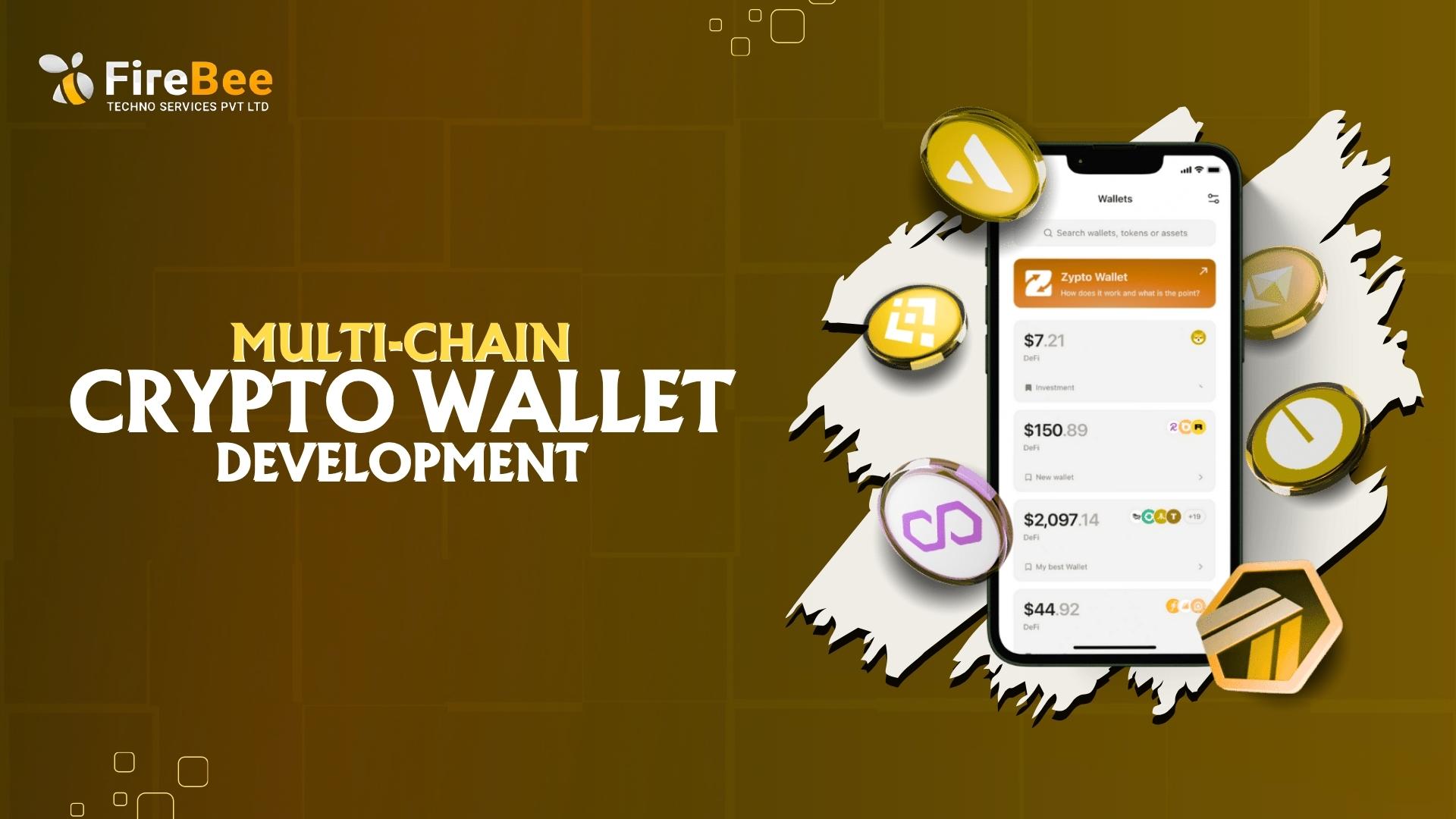
Multi-Chain Crypto Wallet Development Guide: How to Build a Secure Cross-Chain Wallet

Digital wallets have transformed the way people handle and utilize their money online. On top of standard crypto wallets, multi-chain crypto wallets let traders work with various kinds of coins from many blockchains on a single platform.
These wallets offer better control, faster switching between networks, and easier coin swapping. Developers who build these wallets must focus on safety, user experience, and adding features that make daily transactions simple. This guide will show everything about multi-chain crypto wallet development, from how it works and the technology it needs to the steps of building one, popular wallet examples, key safety tips, and the benefits for users and businesses.
The blog aims to help both new and experienced readers understand why multi-chain wallets are now a top choice for digital money handling.
What is Multi-Chain Crypto Wallet Development?
Multi-chain crypto wallet development is the method of developing a digital wallet that enables various digital assets and blockchain systems under one roof. Multi-chain wallets allow users to manage digital currencies like BNB Chain, Solana, Bitcoin, Ethereum, and others using a single, user-friendly interface, in contrast to standard wallets that only handle one blockchain. By doing this, customers can eliminate the hassle of maintaining many wallets for various tokens.
Why You Need a Multi-Chain Crypto Wallet?
There is more to the blockchain environment than just one or two chains. Separate dApps and bitcoins run on separate chains, and investors frequently own assets from multiple chains in order to widen their holdings. Managing several wallets on every blockchain takes a lot of work and is ineffective. A multi-chain wallet optimizes this by offering one platform where users can:
- Reach every user’s digital assets effortlessly.
- Perform cross-chain swaps and transmissions.
- Keep track of portfolio values across chains
- Improve convenience and reduce the risk of losing keys
How Multi-Chain Crypto Wallets Work
It is possible to simultaneously combine many blockchains with a multi-chain wallet. When a new coin is created, the rules of that particular system are utilized to produce a distinct wallet address; for example, an Ethereum address and a Bitcoin address appear very different. All these addresses are created from a single set of keys, keeping things secure yet simple to operate. Many wallets also contain tools for exchanging coins immediately across blockchains.
Automatic network shifting takes place in silent mode. The wallet communicates with the appropriate blockchain to display the accurate amount and transaction history when a user chooses a coin.
The Technology Stack Behind Multi-Chain Wallet Development
A variety of tech stacks must be combined to create a multi-chain wallet. These are the essential elements:
- Node applications like Bitcoin Core or Geth
- Secure APIs for connecting with blockchain nodes
- Strong encryption Types (like AES) to safeguard confidential data
- Database systems, including MongoDB, for handling user information and functions
Multi-Chain Crypto Wallet Development Process
Here’s a step-by-step approach for multi-chain crypto wallet development:
1. Set Up the Development Environment
Prepare by installing key tools and libraries. Connect to test networks for safe, early testing.
2.Design the Wallet Architecture
Plan how your wallet will work from both the user and technical sides, highlighting simplicity and seamless navigation.
3.Smart Contract Creation
For chains that use smart contracts, write safe code to control transactions and token conversions.
4.Frontend Development
Design the user interface, prioritizing making it simple and available on various platforms.
5.Backend Development
Handle blockchain integration, transaction processing, data storage, and user authentication.
6.Security Implementation
Add routine inspections, data protection, solid access control, and dual verification.
7.Testing and Quality Assurance
Evaluate the wallet on numerous chains and systems to find errors.
8.Launch and Maintenance
Once ready, deploy the wallet for public use and provide regular updates based on feedback and industry changes.
Examples of Existing Multi-Chain Crypto Wallets
Several popular wallets demonstrate what’s possible with multi-chain crypto wallet development:
- MetaMask: One of the first to Enable Various blockchains like Binance Smart Chain and Ethereum Smart Chain
- Exodus: incredibly user-friendly and compatible with more than 200 currencies on various systems
- Trust Wallet: it contains Solana, Bitcoin, and Ethereum, among more than 100 networks. Bitcoin,
- OKX Wallet: Provides Modern DeFi tools alongside Standard storage
- Math Wallet: Supports over 100 chains with Special capabilities like Multiple-key security
- Guarda Wallet: Flexible and Advanced, Supporting more than 50 blockchains
Security Considerations in Multi-Chain Wallets
Protection is essential for any crypto wallet, but it’s especially vital for a multi-chain solution due to enhanced difficulty.
Key safety steps include:
- Encrypting all Confidential information and Secret keys
- Using strong, regularly updated passwords
- Two-step verification
- Performing smart contract reviews to detect and resolve vulnerabilities
- Routine software updates to fix security issues
Exploring the Benefits of Using Multi-Crypto Wallets
There are several factors why multi-chain crypto wallet development has turned trendy:
- Convenience: Handle multiple cryptocurrencies without switching across platforms.
- Time-saving: No need to shift assets between wallets to swap or utilize new tokens.
- Cost-effective: Investors can stay clear of slowdowns and unnecessary transaction fees.
- Easy access: Since everything is in one location, tracking transactions and checking quantities is simple.
- Improved DeFi access: Numerous wallets Integrate Instantly to NFT platforms, decentralized exchanges.
Key Features Every Multi-Chain Wallet Must Have
Key features that every multi-chain crypto wallet needs include the following primary modules to offer convenience, security, and an uninterrupted customer interaction in various crypto ecosystems:
- Transaction History and Portfolio Tracking: users should have immediate entry to detailed trading records and be able to monitor the total value of their digital currency holdings.
- Authentication and Access Control: Passcode security, identity verification, and multi-factor authentication (2FA) enhance security by preventing unwanted approaches.
- Cold Storage Support: Connection with hardware wallets or choices for cold storage helps protect major investments from online threats.
- Individual Interface: The wallet should be simple enough to use, making it easy to handle money, check the status of accounts, and make crypto payments.
- Regular Security Updates: The wallet remains resilient to new internet dangers thanks to regular reviews and enhancements.
- Cross-Chain Compatibility: In order to facilitate seamless transactions and crypto exchanges among various blockchain systems, it should effortlessly detect and connect to a variety of networks that are decentralized networks.
Why Choose Firebee as Your Multi-chain Crypto Wallet Development Company?
Firebee is well-known for building blockchain wallets that support many coins and chains safely. The team keeps up with new technology and adds features as users ask for them. They design clear screens, mix easy controls with strong security, and help connect wallets with business apps. Firebee gives clients full support handling coding, testing, security, and updates so wallets stay reliable and up-to-date.
Conclusion
Multi-chain crypto wallet development has made it simple to have assets from many decentralized systems in one place. These wallets combine smart design with robust security and help users enjoy more control, seamless trades, and entry to new DeFi apps. Whether for personal use or business, building a wallet like this is now a key step ifn offering modern, flexible crypto services. With trusted developers like Firebee, getting a secure, smooth wallet is possible, helping users handle coins confidently for years to come.






